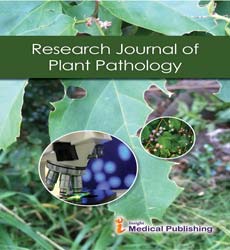Diseases, Symptoms and Management of Papaya
Jorge Alberto Marques Rezende*
Department of Plant Pathology, University of São Paulo (USP), Escola Superior de Agricultura Luiz de Queiroz (ESALQ), Tokyo, Brazil
- *Corresponding Author:
- Jorge Alberto
Marques Rezende
Department of Plant Pathology,
Tokyo University of São Paulo (USP),
Brazil,
E-mail: jrezende@usp.br.
Received Date: January 08, 2021 Accepted Date: January 22, 2021 Published Date: January 29, 2021
Citation: Rezende JAM (2021) Longlasting Systematic Roguing for Effective Management of CABMV in Passionflower Orchards through Maintenance of Individualized Plants. Plant Technol Rev Vol.4 No.1: e001
Abstract
Diseases are a significant limiting factor for papaya production. The nature and frequency of these diseases depend on local conditions and effective management depends on a thorough knowledge of the pathogen, host plant, environment, and their interaction. The precise identity of the causal agent is of paramount importance, and disease management options must be economical. Assessment of disease incidence or severity, and fruit loss are the key factors in determining the economics of disease management. In general, disease management strategies involve different practices that include plant resistance, and prophylactic and curative measures. The papaya diseases related have diverse etiologies, divided into those with biotic (infectious) and abiotic (noninfectious) etiologies that affect the fruit and those affecting the plant. We have attempted to emphasize procedures for diagnosis and control with detailed information on each. Descriptions of pathogens are provided in sufficient detail to assist professional diagnosticians in making accurate diagnosis. Fungicides used to control many of the diseases described in this chapter are mentioned for information proposes only. Legal restrictions and regulations of fungicide use vary among countries, and regulations within any country are subject to change over time. The information reported has been extracted from the available scientific literature and the authors’ experience, and we hope that this publication will provide a helpful reference to growers, students, and professionals working with papaya.
Keywords
Diseases; Papaya production; Disease management; Plant resistance
Foot Rot of Papaya
• Appearance of water-soaked patches on the stem near the ground level.
• If the disease attack is mild, only one side of the stem rots and the plants remain stunted.
• Fruit if formed are shriveled and malformed. Gradually the plant dies.
Management
The best way to keep the fungus from taking hold is to plant your papaya saplings in well-draining soil. When transplanting, make sure the soil line is at the same level on the trunk that it was before – never build up the soil around the trunk. When planting saplings, handle them with care.
Anthracnose
• Disease occurs both in field and in storage conditions.
• The spots on fruits first appear as brown superficial discolouration of the skin which develops into circular, slightly sunken areas and 1 to 3 cm in dia.
• Gradually the lesions coalesce and sparse mycelia growth appears on the margins of the spots.
• Under humid conditions, an encrustation of salmon pink spores is released.
• Infection at early stages of fruit results in mummification and deformation.
Management
Before papaya flowers appear or just as they appear, preventative fungicides may help control papaya anthracnose. Use a fungicide containing Copper hydroxide, Mancozeb, Azoxystrobin or Bacillus. Spray the orchard with the fungicide every two to four weeks.
Powdery Mildews
Symptoms
• On the under surface of disease leaves are found patches of whitish powder growth.
• On upper surfaces, leaves at the infection site show blotches of yellow or pale green usually near vein, surrounded by normally colored tissue.
• Fungus grow superficially on the undersurface of the leaves with drawing nutrients from the cell of leaf surface by specialized absorbing structure known as haustoria.
Management
Plant in sunny areas as much as possible, provide good air circulation, and avoid applying excess fertilizer. A good alternative is to use a slow-release fertilizer. Overhead sprinkling may help reduce powdery mildew because spores are washed off the plant.
Papaya Ring Spot Disease
Symptoms
• Infected plant initially shows cholorsis on youngest leaves followed by vein clearing, rugosity and prominent mottling of laminae.
• Malformation and reduction of the lamina which may become extremely filliform.
• Characteristically elongated dark green streak develop on petiole and upper half of the stems, infected fruits show circular concentric rings causes upto 56-60 % yield loss.
• Pathogen belongs to Potyvirus group of Potyviridae family.
Management
There is no cure for papaya ringspot disease and the disease is very difficult to control once it has become established. In home gardens within the biosecurity zones, infected plants should be removed as soon as symptoms are noticed
Papaya Mosaic Disease
Symptoms
• Causes leaf mosaic and stunting in papaya.
• Young seedlings in the greenhouse show vein-clearing and downward cupping of the leaves about 5 days after inoculation.
• A mottle or mosaic develops after 15-20 days.
• Symptoms appear on the young leaves of the plants.
• The leaves are reduced in size and show blister like patches of dark-green tissue, alternating with yellowish-green lamina.
• The leaf petiole is reduced in length and the top leaves assume an upright position.
Management
Disinfect working tools or heat them in an oven at 150°C for 1 hour to kill the virus. Working tools or gloves can also be dipped in 0.525% sodium hypochlorite and then rinsed in water.
Conclusion
The chemicals listed for control of papaya diseases should be considered dangerous. The manufacturers' recommendations for application and handling should be strictly adhered to. Before using any pesticide, growers should always check its current status with their county agent or the local representative Food and Drug Administration.
Open Access Journals
- Aquaculture & Veterinary Science
- Chemistry & Chemical Sciences
- Clinical Sciences
- Engineering
- General Science
- Genetics & Molecular Biology
- Health Care & Nursing
- Immunology & Microbiology
- Materials Science
- Mathematics & Physics
- Medical Sciences
- Neurology & Psychiatry
- Oncology & Cancer Science
- Pharmaceutical Sciences
